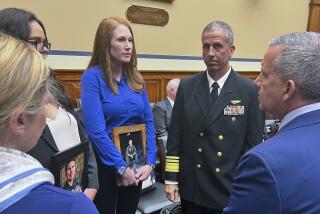Pentagon eases flight restrictions on Air Force’s F-22 Raptor jets
- Share via
Defense Secretary Leon E. Panetta has approved a plan to begin lifting flight restrictions that he placed on the Air Force’s problem-plagued fleet of F-22 Raptor fighter jets.
Since 2008, F-22 pilots have reported more than a dozen incidents in which they experienced hypoxia-like symptoms in the air. Hypoxia is a condition that can bring on nausea, headaches, fatigue or blackouts.
In May, Panetta ordered that any flights in a F-22 “will remain within the proximity of potential landing locations to enable quick recovery and landing should the pilot encounter unanticipated physiological conditions during flight.”
But after more than a year studying the issue, the Air Force has made two changes to the plane to solve the hypoxia problem. These changes have prompted Panetta to gradually begin to lift the restrictions.
The Air Force believes that the root cause of the events are pressurized vests that F-22 pilots wear to combat high gravitational forces on the body. When the vests expanded, they restricted pilots’ breathing, Pentagon spokesman George Little said at a Tuesday media briefing.
The Air Force found that a faulty valve “caused the vest to inflate and remain inflated under conditions where it was not designed to inflate, thereby causing breathing problems for some pilots,” he said. “The garment has been suspended from flight since June.”
The Air Force also removed a high-efficiency particulate air filter consisting of activated carbon and charcoal. Tests proved the new filter negatively affected the breathing system.
Rep. Adam Kinzinger (R-Ill.) and Sen. Mark R. Warner (D-Va.), who have hounded the Air Force to get to the bottom of the F-22 saga, issued a combined statement that urged caution.
“It makes sense to maintain a majority of Secretary Panetta’s safety restrictions on the F-22 while the Air Force looks further into potential issues with a valve and a hose that connects to the survival gear worn by pilots,” the statement said. “We certainly look forward to much more specific information about these problems and proposed solutions during our briefing with the Air Force, which has been scheduled for July 31st.”
F-22s will now resume long-duration flights for deployments.
During the news conference, Little said that Panetta authorized deployment of a squadron of F-22 aircraft to Kadena Air Base in Japan.
According to the Air Force, each F-22 costs $143 million. Counting upgrades and research and development, the U.S. Government Accountability Office estimates each F-22 costs taxpayers $412 million.
The F-22, made by Lockheed Martin Corp., is the world’s most expensive fighter jet and has never been used in combat since entering service in 2005.
ALSO:
Fatal problems plague the U.S.’ costliest fighter jet
Some pilots refuse to fly F-22 Raptor amid jet’s oxygen problems
F-22 Raptor oxygen problems may be worse than previously disclosed
Follow W.J. Hennigan on Twitter @wjhenn
More to Read
Inside the business of entertainment
The Wide Shot brings you news, analysis and insights on everything from streaming wars to production — and what it all means for the future.
You may occasionally receive promotional content from the Los Angeles Times.











